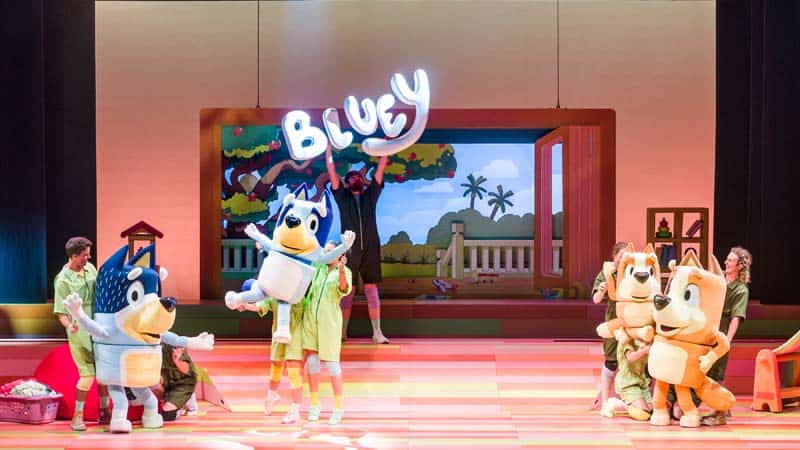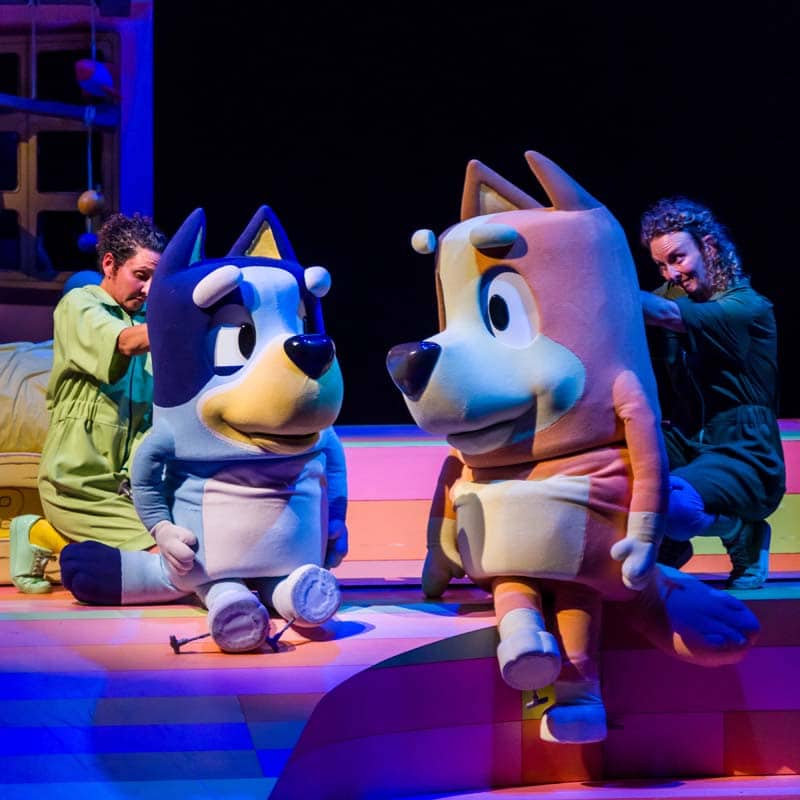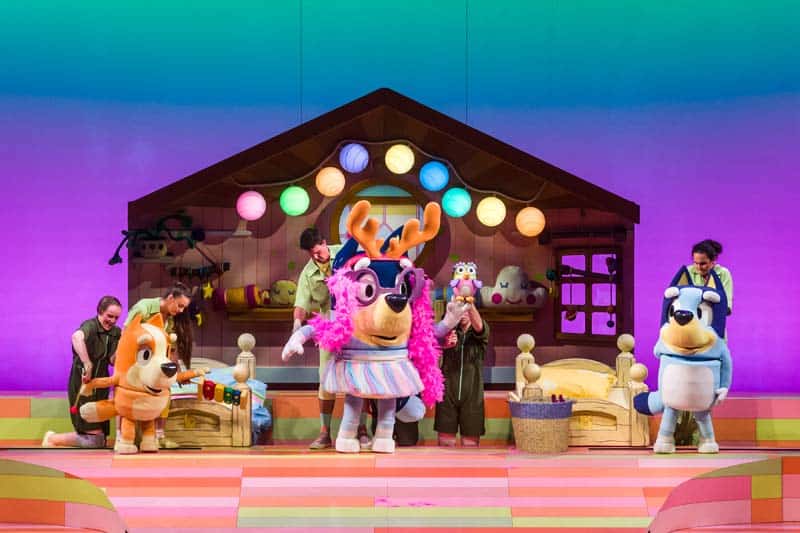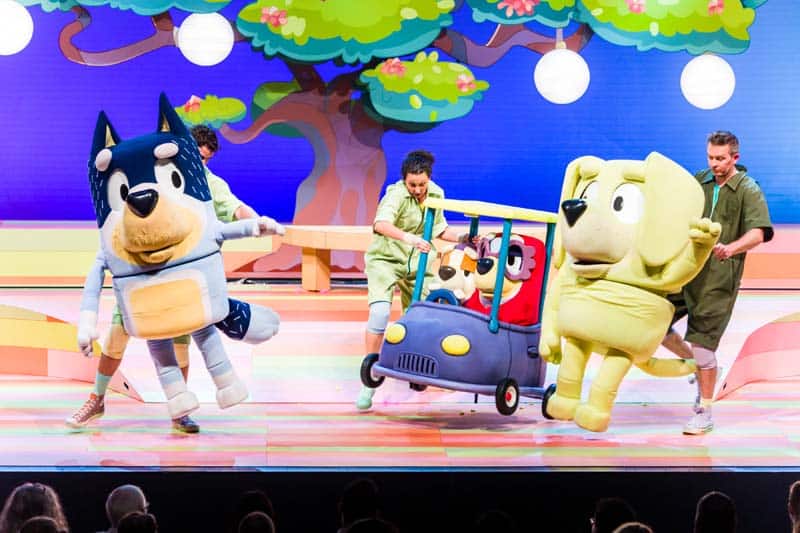Behind the Scenes with Bluey! “Bluey’s Big Play” Coming to The Straz Center
Hooray! Bluey is heading to Tampa for her first-ever live stage show! Bluey’s Big Play hits The Straz Center on April 29 and 30 with a show that families and kids of all ages will love. The show follows Bluey and Bingo as they pull out all the games and cleverness to get dad off his bean bag chair and out to play. The brand-new theatrical adaptation of the Australian-based Emmy-award-winning children’s television series features brilliantly created puppets, a new story and all-new songs.
We recently had the chance to chat with Jacob Williams, the tour’s puppet director. Here’s Williams’ inside scoop on what to expect, what goes into the show, and how the lovable Australian cattle dog has made an impact here in America.
A lot of the creatives in the Bluey TV show helped bring the stage show to life.
Bluey’s Big Play was created by Windmill Fitter Company, an award-winning theatre company in Australia, and Ludo, who creates the animation for Bluey. The script is written by Joe Brum, who created Bluey, and the music is by Bluey composer Joe Brofft. “We wanted to make it a beautiful stage show for kids to come and see,” Williams says.

You’ll hear some familiar voices.
The stage show will be voiced by the same actors who voice the TV show. The voices are pre-recorded and played to a live track along with the puppets, so they’ll be recognizable to children in the audience. “It really is as if you're seeing Bluey and Bingo and Bandit and Chilli on stage, and particularly here in America, I think they're all quite iconic characters of their age groups, and the crowds are just lapping it up,” Williams says. “American crowds are very vocal crowds, so the puppeteers and performers, they're really getting that feedback straight away.”
Bluey, Bingo and friends are no ordinary puppets.
To transform Bluey’s 2D world to the 3D world, the production uses a Japanese form of puppetry called bunraku, where you're directly holding the large, life-sized puppets. Each puppet has two people and they come and go, performing with their legs. “Without giving too much away, there's mechanics that make their eyes move, their eyebrows and their mouths,” says Williams. “Bandit is about six feet tall on stage and it takes two puppeteers to perform him—one person on the feet and the arms, and another person on the head.”
“The wonderful thing about puppetry is we can take Bluey and make Bluey look exactly like Bluey in 3D. I remember when we opened it up in Brisbane, Joe Brum, Bluey’s creator, was just so enamored by something that he created that people made puppets of, and he's seeing it on stage. He said that in in the animation process, they don't get that instant feedback that the puppeteers get on stage.”

Training to be a puppeteer for Bluey takes a lot of hard work.
In Australia there aren’t many places to train as a puppeteer. Williams started off as an actor who trained through smaller workshops with a company that needed a puppeteer for their show. He now trains others wanting to do the same.
“You kind of learn on the road or with sort of more experienced puppeteers,” he says. “A lot of our performers are dancers and actors that I've trained in puppetry and there are a few puppeteers that I've trained as well. It's a real mix of people's skill level within the show, and it's very physical and disciplined. You have to be sort of fit and strong and certainly by doing a show like this, you get fitter and stronger as you perform.”
It takes a lot of dedication and teamwork to get the show up and running.
The Bluey team is comprised of nearly 30 people. They’re on a bus four days of the week, and then three days, they're in a hotel. “We do the show in the morning and then we'll pack up the show and then at nighttime, we'll jump on the bus and drive off to the next place,” says Williams. “And overnight we sleep on the bus and then we wake up in a new city the following morning, and often it's quite disorientating opening the bus because on the buses, you can't see out the windows. They're very dark, like sort of time capsules. You open the door and you're in a completely new city and new surroundings. We load the set and do a tech rehearsal and then do a couple of shows and then pack it up, jump on the bus and do it all again. We're crisscrossing everywhere, and America's got such an amazing variety of landscapes. It's a real thrill to be able to see it.”

It’s not just for younger kids. The show has made an impact on all ages.
Williams has two children, ages 12 and 15, back home in Melbourne, Australia, who still love Bluey as much as younger kids do. “My daughter's 15, but she still loves Bluey and they've tapped into sort of play and imagination, which the show does so well. I think that’s essentially what we do in our career is we play. And for a job, I think that's a really wonderful creative household to grow up in.”
Bluey first premiered in America right when the lockdown hit in early 2020. “Normally, kids just watch their programs by themselves, [but] the lockdown and family staying together afforded them the opportunity to sit down and watch it together,” Williams says. “One great thing about my job is I sit in the audience a lot of the time to watch the show and make sure it looks good. So, I get to sit amongst the audience and see the adults having as much fun as kids. It’s really blown us away just how much it's made an impact here in America, this little animation that comes out of Brisbane, Australia, and how much people relate to the character, which is really just fantastic.”
Check out “Bluey’s Big Play” at The Straz Center on April 29 and 30. Visit strazcenter.org for more information, including tickets and VIP add-ons.
Photo credit: Credit Darren Thomas | Originally published in the April 2023 issue of Tampa Bay Parenting Magazine.


